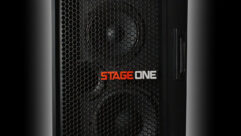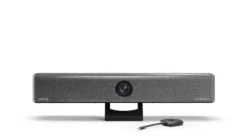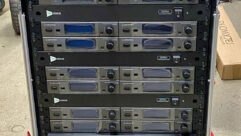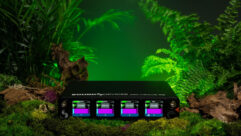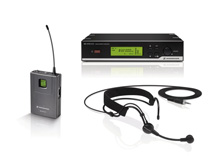

Sennheiser XSW 52 Headworn Wireless Mic Review
Aug 17, 2012 11:56 AM,
Reviewer: John McJunkin
A prosumer-grade mic fit for pro AV installation.
As science marches forward, technology continuously improves and equipment manufacturers introduce better products. A result of this progress is that manufacturers’ consumer-grade offerings often reach the level formerly occupied by their professional-grade products—making them, in spite of a lack of bells and whistles, a very good value. A perfect example of this shift is Sennheiser’s new XSW series microphones, which are as good as yesterday’s great mics, but at a reasonable price in today’s market.
The XSW line of mics consists of packages that include mic, transmitter, and receiver all in one box. The XSW 12 includes an omnidirectional lavalier microphone; the XSW 35 and 65 integrate transmitters into handheld cardioid microphones, dynamic and condenser (and cardioid and super cardioid), respectively. The XSW 72, which does not include a microphone at all, broadcasts the output of your musical instrument via a bodypack transmitter. I was sent an XSW 52 for evaluation, which includes an ME 3 headset microphone. As Sennheiser implies in its documentation, the headset is intended for a more “animated” performance, and indeed, the use of a headset mic helps to ensure that the microphone capsule remains at the same distance from the performer’s mouth no matter what—something that a lavalier mic cannot accomplish.
The ME 3 is a supercardioid electret condenser mic mounted at the end of the boom that’s integrated into a wrap-around headset mic structure. The structure is plastic that wraps over the top of the ears and then around the back of the head. An adjustable cloth band is placed just above the flexible plastic material of the headset, helping to keep the mic in place, and increasing the comfort level of the user. I all but forgot that I was wearing it, though one minor issue might be that the mic can only be worn on the right side of the performer’s head.
The mic’s cable terminates in a 3.5mm TRS connector. The element’s large windscreen does not conceal the mic from the view of the audience, but this could be a positive for certain applications. For example, dancing performers often use a prerecorded lead vocal, but the performer may wish to speak to the audience between songs, so a dummy microphone won’t do. In order to contribute to the illusion, many such performers prefer to use a headset mic with a large element or windscreen, exaggerating to the audience that a mic is being employed, implying they truly are singing (as distinct from an ultra-small match-head microphone on an ultra-slender boom, which may be invisible to the audience).
The SK 20 bodypack transmitter included with the XSW 52 set is approximately the size of a deck of cards, and outputs its signal in one of four different frequency ranges detailed in the specifications section of this review. Its output is 10mW, yielding a range of about 250ft. Its audio upper frequency limit is 16kHz, and the lower limit is 50Hz for line level signals, and 80Hz for mic level signals. It operates for approximately 10 hours on two AA batteries. LEDs atop the bodypack indicate power and muting status. Along with the mic/instrument input atop the enclosure are the transmitter’s integrated antenna and mute button. On the front of the enclosure is the unit’s LCD display, and on the sides are control switches and buttons.
1
Sennheiser XSW 52 Headworn Wireless Mic Review
Aug 17, 2012 11:56 AM,
Reviewer: John McJunkin
A prosumer-grade mic fit for pro AV installation.
The EM 10 receiver included in the kit is a half-rack-space true diversity receiver. As with the system’s transmitter, it is very simple to operate, with minimal controls and a simple LCD display on the front panel, just four navigation buttons, a power button, and a level knob. The rear panel has only 1/4in. unbalanced and XLR balanced audio outputs and two 50Ω BNC connectors for its antennae, along with a line/mic output level switch, a squelch threshold knob, and power inlet fed by a wall wart.
The system is very simple to set up and use. I unboxed it and had all the hardware in place and ready to go within minutes. The frequency of the receiver can be determined one of three ways: manually, via preset, or by scanning. Scanning is the easiest way to go. Once the receiver’s frequency is determined, it’s transferred to the transmitter by first pressing the sync button of the receiver, and then that of the transmitter. The other controls are self-explanatory; muting and input sensitivity, for instance. I was able to start transmitting within moments after the hardware setup.
I evaluated the mic with a broad range of voices—male and female, young and old, spoken and sung, loud and soft. I actually created an a cappella multitrack recording with my own voice, and I was pleased with the result. I favor condenser mics due to the higher resolution in capturing transients and higher frequencies, and this mic delivered. Also, I used the mic in proximity to both monitors and front-of-house speakers. Of course, upon getting close enough to the speakers, feedback occurred, but only at surprisingly close distances. This is a big benefit of the super-cardioid pattern of the mic. It represented the full spectrum of the human voice very well and smoothly from top to bottom. The capsule can take 150dB of SPL without significant distortion, which is far more than enough.
The XSW series microphones benefit from the development of better materials, better design, and better construction, all of which have improved over the years. This is a system that would have been considered for delivery of full-on professional results in years past, and despite the fact that it’s considered a prosumer or even consumer-grade product with a price appropriate to that level of quality, it really delivers solid results. It lacks some of the bells and whistles of higher-end systems, but sounds great, is easy to use, and is definitely worth a look.
Product Summary
Pros: Good value, comfortable headworn mic, easy sync of wireless system
Cons: Mic can only be worn on the right side of the head
Applications: Musical vocals, speech, stage, house of worship
Price: $449
Specifications
System-wide
Frequency ranges: A: 548-572MHz GB: 606-630MHz; B: 614-638MHz; C: 766-790MHz; E: 821-832MHz and 863-865MHz
Switching bandwidth: 24MHz (range E: 13MHz)
Signal-to-noise ratio: ≥103dBa
THD: ≤1%
EM 10 receiver
Sensitivity (at peak deviation): < 3 μV at 52dB arms S/N
AF frequency response: 50–16,000Hz
Dimensions: 200x42x127mm
Weight: 730 grams
SK 20 transmitter
RF output power: 10mW
AF frequency response: 50–16,000Hz (Line); 80–16,000 Hz (Mic)
Power supply: 2 AA size batteries, 1.5V
Operating time: Approx. 10 hours
Dimensions: 66x96x24mm
Weight: 95 grams
ME 3 microphone
Transducer principle: Condenser, pre-polarized
Sensitivity: 1.6mV/Pa
Pick-up pattern: Cardioid
Maximum SPL: 150dB
John McJunkin is the principal of Avalon Podcasting in Chandler, Ariz. He has consulted in the development of studios and installations and provides high-quality podcast-production services.
2


